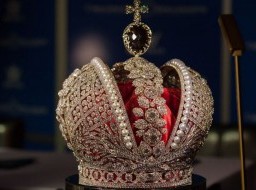The Palace of the Facets
The Faceted Palace is an unique part of the original royal palace built in the late 15th century by Ivan III. The palace is the oldest stone civilian architectural monument, not only in the Kremlin but in the whole of Moscow. It was once used as a banquet and amazing reception hall for the tsars and their most important visitors. The walls and vaults of the Faceted Chamber are covered with fabulous murals. Magnificent and solemn, these murals re-create the atmosphere of a gala medieval hall.The palace produces an unforgettable impression! In the very center of the Moscow Kremlin, in Cathedral Square, there stands the oldest surviving monument of the secular architecture of Moscow— the Palace of the Facets. Among all gems of the Kremlin architectural ensemble the Facets Palace holds special place. The history of this handsome palace is rather interesting. In 1462, Ivan III ascended to the throne proclaiming himself the "Tsar of All Rus". In 1472 the Italian architects Marco Ruffo and Pietro Antonio Solario came to Moscow. At that time, large-scale construction was under way in Moscow. In 1485, construction of a new amazing palace for the tsar commenced. It was finished in 1508 after the death of Ivan III. His son, Prince Vassily III, became the first owner of the palace. The palace was rebuilt many times from the second half of the 16th to the 17th century - under Ivan the Terrible, Boris Godunov and the first tsars of the Romanov dynasty. Only the gala throne hall – the Facets Palace – has been preserved to our days out of the sumptuous monumental building of the 15th century. Its main facade looks out over Cathedral Square, which in olden days witnessed solemn coronation processions, religious ceremonies, and receptions of foreign ambassadors. The facade of the Palace is faced with white stone slabs rusticated into four facets, hence the name of the Palace – the Facets (Faceted) Palace. The Throne Hall, the largest one at that time (500 square meters in area, 9 meters high) has a cross vaulted ceiling propped up by a massive pillar in the middle lavishly decorated with white-stone gilded ornaments representing dolphins, birds and beasts. The portal of the Facets Palace is just as lavishly decorated with stylized floral ornament and mythological beasts. The paintings on the east wall are of special significance. The point is that the southeast corner was the place where the tsar's throne once stood. The east wall and a part of the south wall which served as background for the tsar sitting on the throne, are painted with subjects based on "The Tale of the Brothers of Vladimir". These compositions are pictorial representations of historical continuity, and consequently, the legality of the power of Moscow princes. This idea should have underlain the efforts to unify separate principalities each upholding their independence into an integral state. The painting on the south wall represents the presentation of the tsar's regalia to Prince Vladimir Monomach. Tsar Fyodor (son of Ivan the Terrible) and Boris Godunov are also depicted there. On the sloping walls at the windows there are twenty-four stylized portraits of Russia's rulers who brought fame to their country by their glorious deeds. The subjects of the frescoes of the Facets Palace seem to invite one to draw a parallel between the biblical stories and events of the Russian history. For instance, the rise to power of the Russian Tsar Boris Godunov and the parable about Joseph the Beautiful from the Old Testament. Opposite the tsar's place, on the west wall of the palace, there are scenes from the didactic parable about the just and adjust judges, placed there as a reminder to the tsar of his duty. The Gala Hall was used for official and solemn events: it was here that the state Councils were convened and the Boyars' Duma (Council) held its sessions, foreign ambassadors were received and heirs to the throne named. Hence, the hall saw many significant events in Russian history. Feasts and receptions were organized with especial luxury. The boyars, dressed in luxurious velvet and brocade garments, with tall sable hats on their heads, were sitting on the benches placed along the walls; in special cases standing around the central pillar gala utensils and vessels were displayed. Admire the magnificent atmosphere of this unique place! |
|

































































